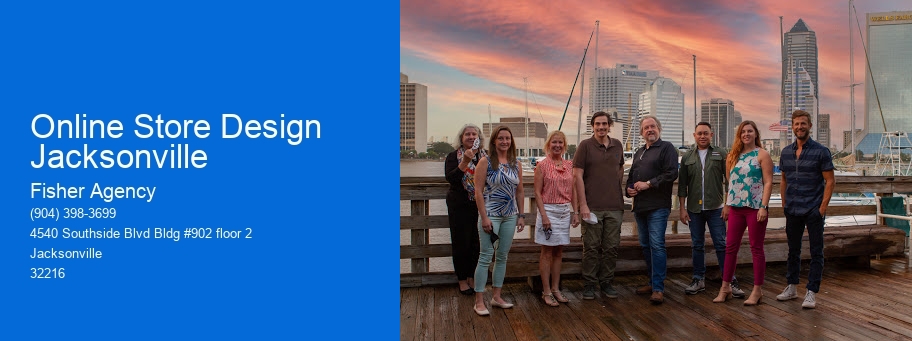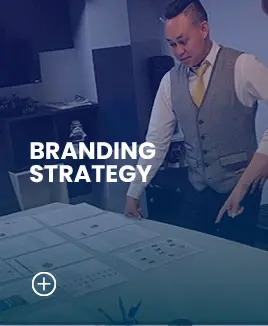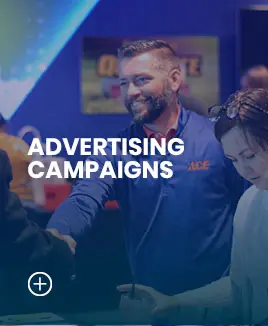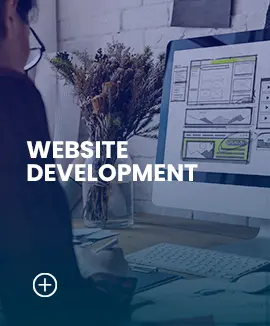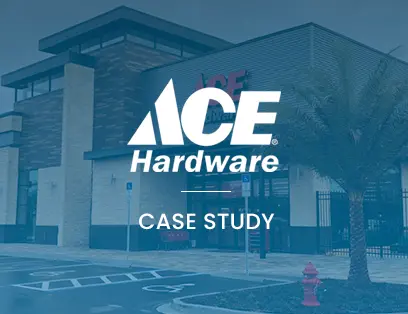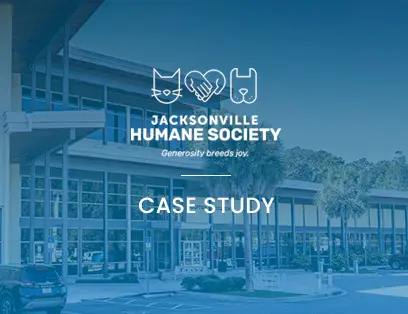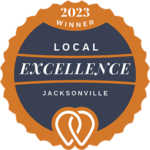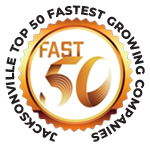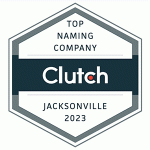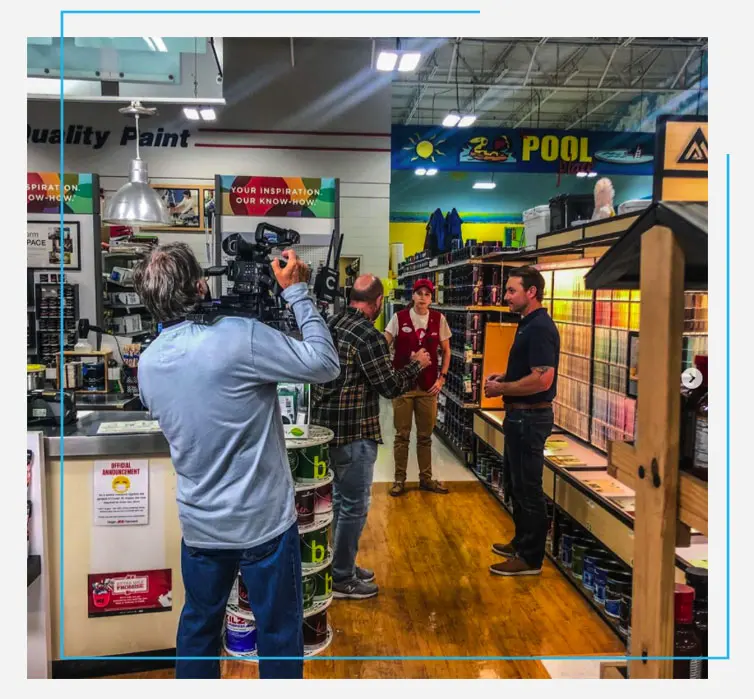Are you looking to grow your business through lead generation? Maybe you need a fresh new brand to increase leads. At Fisher Agency, a top marketing and design agency based in Jacksonville, FL, we have some of the best marketing strategies that will help you hook new clients. It doesn’t matter if you’re a Fortune 500 company or a small business; we can find the marketing angle that works best for you. If you are looking for web design, we do that. If you are looking for branding and logo design, we do that. And, if you are looking for digital marketing, we do that, too. In fact, we can put together a comprehensive marketing plan to determine the most cost-effective advertising strategies for you.
Online Store Design Jacksonville: Creative Digital Style Solutions In Jacksonville Assist Elevate Your Online Presence
Solutions Provided by Website Design Agencies
Ever felt overwhelmed by the sheer complexity of launching a site? Lots of organizations in Jacksonville stumble over tangled lingo, confusing designs, and the evasive quest for responsive design. The digital world awaits nobody, and a chaotic or sluggish site can make visitors disappear faster than a summer storm. But what if the solution was as easy as partnering with the best Website design Agency Jacksonville!.
?. !? Fisher Agency shines here, transforming these obstacles into chances. Picture a service that doesn't simply develop a site but crafts an experience tailored completely for your audience. They take the mayhem of coding and material and turn it into a symphony of seamless navigation and engaging visuals.
Core Services Delivered
- Custom-made Website Style: Unique layouts that speak your brand name's language.
- Mobile Optimization: Every pixel polished for flawless display screen on phones and tablets.
- SEO Combination: Enhancing exposure so your site does not simply exist however grows in search rankings.
- Material Technique: Crafting messages that resonate and transform visitors into loyal clients.
- E-commerce Solutions: Setting up stores that are both appealing and easy to utilize.
Why settle for generic templates when Fisher Agency provides customized services that anticipate challenges before they appear? Their technique resembles having an experienced guide in the thick forest of digital marketing - they light up courses with specialist accuracy.
| Challenge | Fisher Agency's Option |
|---|---|
| Slow-loading pages | Advanced optimization strategies to ensure lightning-fast load times |
| Poor user engagement | Intuitive UX/UI styles that mesmerize and retain visitors |
| Low online search engine rankings | Comprehensive SEO techniques embedded in design and material |
Isn't it interesting to believe that all these obstacles can be not only get rid of but changed into strengths? The Fisher Agency does not simply attend to these problems-- they anticipate them, guaranteeing your digital presence is both robust and future-proof. In the dynamic Jacksonville market, their know-how makes them a beacon for businesses eager to shine online.
Distinctive Qualities of Jacksonville Website Design Companies
When diving into the dynamic world of website design in Jacksonville, the complexity frequently lies not in the visual appeal but in how the website performs across gadgets, internet browsers, and user expectations. The Fisher Agency comprehends that creating a website is comparable to crafting a living organism-- it should adjust, breathe, and progress.
Envision launching a site that looks stunning on your desktop however turns into a jumbled mess on a smart device. This inconsistency can calmly wear down user trust and spike bounce rates. Fisher Agency's technique focuses on responsive design with careful attention to detail, making sure seamless performance whether on a phone, tablet, or 4K display.
Core Aspects Jacksonville Firms Must Master
- SEO Integration: Enhancing code and content so online search engine do not just find your website but rank it plainly.
- User Experience (UX): Instinctive navigation courses that feel natural, not forced.
- Performance Optimization: Lightning-fast load times accomplished through wise asset management and server configurations.
- Accessibility: Creating for all users, consisting of those with specials needs, to expand reach and adhere to legal requirements.
Web designers in Jacksonville likewise battle the undetectable foe of over-cluttered style. A lot of elements can overwhelm visitors, diluting the message and causing lost conversions. Fisher Agency applies a minimalist approach that doesn't sacrifice richness but sharpens focus-- like a carefully tuned tune rather than a loud jam session.
Professional Tips for Navigating Web Style Intricacy
- Utilize a grid system to keep alignment and balance-- turmoil is not imaginative here.
- Focus on above-the-fold content; first impressions are mercilessly decisive.
- Utilize vector graphics and SVGs to keep visuals crisp at any resolution.
- Test on real devices-- not simply simulators-- to catch peculiarities and glitches early.
Fisher Agency's mastery lies in effortlessly mixing these subtleties into cohesive, high-performing digital experiences. Their work is a testimony to the truth that Jacksonville website design isn't simply about aesthetic appeals; it's about engineering trust, engagement, and development at one time.
Unlocking the Power of Distance in Web Design
Ever discovered how a face-to-face chat can trigger concepts that emails never quite record? That's the secret sauce behind hiring local web style experts. When you team up with someone simply around the corner, the back-and-forth is immediate, genuine, and teeming with nuance. Fisher Agency understands this well-- they flourish on fast pivots and spontaneous conceptualizing sessions that only distance can nurture.
The Subtle Art of Cultural Positioning
Think of crafting a site that speaks the language of Jacksonville's vibe-- its rhythm, colors, and neighborhood spirit. Regional designers aren't just coding devices; they're cultural interpreters. Fisher Agency take advantage of this local pulse, blending it seamlessly into user experience and responsive style. This isn't simply design; it's a discussion with your audience.
Expert Tips for Making The Most Of Regional Partnership
- Take advantage of in-person workshops: They open concealed insights that remote calls frequently miss out on.
- Use real-time feedback: Catch and correct visual or functional tweaks before they become expensive.
- Stay attuned to local SEO trends: It's not simply keywords, but local search behavior that forms your presence.
Why Time Zones Matter More Than You Think
Working across continents can mean delays that slow momentum to a crawl. Fisher Agency's Jacksonville-based group operates in your time zone, turning hours that might otherwise disappear into efficient bursts. This leads to faster website launches and early adoption of digital marketing methods.
Local Insight Table: Fisher Agency's Edge
| Aspect | Regional Specialists | Remote Alternatives |
|---|---|---|
| Cultural Significance | High-- Deep neighborhood understanding | Low-- Generic or broad strokes |
| Interaction Speed | Immediate, face-to-face possible | Often delayed by time zones |
| Customization | Tailored to regional audience | Standardized with less nuance |
Emerging Aesthetics and Performance in Jacksonville's Digital Scene
Ever noticed how some sites in Jacksonville seem to breathe, almost alive with the pulse of the city? It's not magic-- it's an accurate mix of user experience and creative vision. The biggest hurdle for regional companies is catching the vibrant, eclectic spirit of Jacksonville while keeping smooth navigation. Fisher Agency understands this balancing act exceptionally, changing abstract ideas into intuitive, engaging user interfaces that resonate with regional culture.
Secret Style Trends Forming Jacksonville Organization Websites
- Micro-interactions: Little animations that react to user actions, making sites feel responsive and alive.
- Dark mode: Not just a fad, however a strategic choice to lower eye pressure and improve visual hierarchy.
- Asymmetrical designs: Breaking the grid to develop a dynamic, unforeseeable circulation that shows Jacksonville's varied areas.
- Vibrant typography: Font styles that aren't shy, functioning as both art and navigation markers.
- Localized SEO: Crafting content and structure that speaks particularly to Jacksonville's audience and search intent.
The Fisher Agency's Approach to Browsing Web Design Complexity
When companies wrestle with the maze of responsive style, cross-browser compatibility, and fast load times, Fisher Agency actions in with specialist precision. They dissect every pixel and line of code, ensuring that the site doesn't simply carry out but excels in every environment. Picture a website that loads instantly on your phone, greets you with a familiar Jacksonville ambiance, and guides you easily-- this is their requirement.
Professional Tips from Fisher Agency for Jacksonville Companies
- Prioritize mobile-first design: Jacksonville's on-the-go way of life demands websites that shine on smartphones and tablets.
- Take advantage of local imagery: Integrate genuine visuals from Jacksonville's landmarks to construct trust and acknowledgment.
- Simplify navigation: Avoid frustrating users; simpleness typically results in higher engagement.
- Test rigorously: Utilize genuine devices and browsers typical in the Jacksonville market to catch subtle display screen quirks.
- Update material frequently: Keeping the website fresh aids with SEO and shows an active, thriving organization.
| Pattern | Advantage | Jacksonville Importance |
|---|---|---|
| Micro-interactions | Improves user engagement | Catches the vibrant energy of local users |
| Dark Mode | Decreases eye tiredness, contemporary appearance | Fits diverse lighting environments in the city |
| Localized SEO | Enhances search presence | Targets Jacksonville-specific inquiries successfully |
Leading Website Design Solutions in Jacksonville FL
Jacksonville FL is a dynamic city understood for its extensive park system, stunning beaches, and a growing arts scene. Fisher Agency. It is the largest city by area in the continental United States and boasts a varied population with a strong economic base in financing, health care, and logistics. Popular attractions consist of the Jacksonville Zoo and Gardens, the Cummer Museum of Art and Gardens, and the picturesque St. Johns River. The city likewise hosts numerous cultural occasions and festivals that commemorate its rich history and community spirit
For professional guidance and a complimentary consultation on website design, reach out to Fisher Agency. Fisher Agency. They specialize in producing ingenious web options customized to the special needs of Jacksonville FL services
- Website Design: Developing a site's visual appearance and user experience is key to drawing in and retaining visitors. Effective Website Design improves a brand and guides users smoothly through the online space.
- User Interface Design: User Interface Design concentrates on the aesthetic elements and interaction of a virtual product. A well-crafted UI is vital for developing captivating and intuitive online experiences.
- User Experience: User Experience focuses on how people sense when interacting with a digital product. It has a critical role in creating captivating and effective online platforms.
- Responsive Web Design: Responsive web design guarantees ideal viewing experience across different devices. It's crucial for developing flexible digital interfaces.
- Html: HTML provides the framework and content for webpages. It is essential for making the graphic layout and interactive features of online presences.
- Css: CSS dictates the visual appearance of online content, controlling elements like layout, colors, and fonts. This styling language is vital for creating appealing and user-friendly digital experiences.
- Javascript: Javascript animates web pages, making them interactive and dynamic. It's vital for developing captivating user interactions in online settings.
- Web Accessibility: Web Accessibility guarantees digital content is usable by everyone, consisting of people with disabilities. Incorporating accessibility from the start of development leads to more inclusive and user-friendly online experiences.
- Web Development: Web Development is the making and upkeep of sites on the internet, guaranteeing performance and user experience. It is vital for setting up an online existence and creating engaging digital platforms.
- Content Management System: The Content Management System (CMS) helps in creating, administering, and altering digital content. It lets users to construct and maintain an online presence without requiring any code.
- Search Engine Optimization: Search Engine Optimization enhances online visibility through well-planned content and technical adjustments. This process is crucial to enhance a site's ranking and draw in more organic traffic, leading to greater success for any online venture.
- Wireframe: Wireframes are skeletal layouts that define a digital product's structure and features. They are essential for planning user flows and content hierarchy before visual design starts for online platforms.
- Prototype: A Prototype is a preliminarily version of a system, used to test and refine its functionality and user experience. In interactive application development, prototypes enable designers to visualize the layout and flow of content before final development.
- Bootstrap Framework: Bootstrap is a well-known open-source framework for developing adaptable, mobile-first web apps. It provides ready-made elements and tools that simplify the process of creating consistent and attractive websites.
- Front End Development: Front End Development focuses on creating the user interface and engaging components of a site. It molds the visual presentation and UX of web applications.
- Back End Development: Back End Development is the engine that drives the features and data administration of web applications. It guarantees seamless user interactions by handling server-side logic, databases, and APIs.
- Hypertext Transfer Protocol: Hypertext Transfer Protocol is the foundation for data communications on the web, allowing browsers to request and receive resources from servers. It determines how content is delivered, affecting the framework and display of online creations.
- Domain Name System: This Domain Name System translates human-friendly names into IP addresses, directing users to the correct server. This is key for online presence creation, ensuring people can effortlessly find and access content.
- Web Hosting: Web Hosting provides the required server space and infrastructure for your site to be available online. This is a foundational element that enables the visual creation to reach its intended audience.
- Cross Browser Compatibility: Cross Browser Compatibility ensures a stable user experience across various web browsers. It's crucial for attracting a larger audience and keeping the planned look and functionality of web creations.
- Mobile First Design: Mobile-first design prioritizes creating designs and functionality for more compact screens first. This approach guarantees optimal user experiences across all devices while developing online platforms.
- Conversion Rate Optimization: Conversion Rate Optimization (CRO) enhances the user experience to guide more visitors to intended actions. Implementing CRO strategies is crucial for boosting the performance of an online presence and increasing its potential.
- Typography: Typography substantially impacts user experience by making content readable and interesting on digital interfaces. It creates visual hierarchy and brand identity, affecting how visitors view and interact with the platform.
- Color Theory: Color Theory directs artistic choices, influencing user understanding and engagement. Strategic application of color principles improves visual appeal and user experience for digital interfaces.
- Information Architecture: Information Architecture arranges and structures content to ensure usability and discoverability. It's crucial for developing effective digital experiences.
- User Centered Design: User Centered Design prioritizes the target audience's demands and preferences throughout the development process. This approach makes sure digital platforms are intuitive, easy to use, and useful for their target users.
- Human Computer Interaction: Human-Computer Interaction principles guide the creation of easy-to-use digital interfaces. Considering these principles results in more understandable and efficient online experiences.
- Usability: Usability ensures a site is easy to navigate and comprehend. It's crucial for creating compelling online experiences that meet user needs efficiently.
- Prototyping: Prototyping is crucial for visualizing and assessing interactive layouts before full development. It aids in enhancing user experience and identify possible issues early in the digital interface creation process.
- Interaction Design: Interaction design influences how users interact with digital interfaces. It's vital for creating intuitive and enjoyable online experiences.
- Visual Design: Visual design focuses on the artistic charm and user-friendliness of online interfaces. It shapes user experience, leading visitors through content with well-made layouts and engaging visuals for optimal interaction.
- Accessibility: Accessibility ensures digital content is usable by everyone, regardless of ability. Prioritizing it in development forms inclusive online experiences for all users.
- User Research: User Research informs the procedure of developing useful online sites by understanding user needs and behaviors. This comprehension ensures that the digital product meets user expectations and reaches its desired purpose.
- User Testing: User Testing uncovers how actual people interact with a digital product, finding usability issues and guiding improvements. This feedback is essential for creating effective and user-centered online experiences.
- Navigation Design: Navigation Design leads users through digital interfaces, making sure of simple access to wanted content. It's essential for good user experiences and efficient online property utilization.
- Call To Action: An Call To Action motivates users to take a specific action. This is vital for leading visitors and achieving goals on a digital platform.
- Layout Design: Layout Design organizes items effectively and attractively. It's essential for developing captivating and user-friendly online presentations.
- Content Strategy: Content Strategy guides the planning, creation, delivery, and management of useful and practical content. It makes sure that content is in line with user needs and business goals, forming the overall digital presence.
- Design Patterns: Design Patterns are reusable answers to common coding problems. They streamline the making of websites by providing proven models.
- Heuristic Evaluation: Heuristic Evaluation evaluates a user interface usability based on well-known principles. It aids identify and correct design problems in interactive systems, improving the overall user experience and satisfaction.
- Cognitive Load: Cognitive Load refers to the mental exertion needed to process information. Lowering unnecessary Cognitive Load is vital for developing user-friendly online interfaces.
- User Persona: User Personas are made-up, representative users that help guide decisions about site creation. They guarantee the final product meets target audience needs and goals, leading to a more successful and user-centered digital experience.
- User Interface: User Interface is the point of interaction between a user and a digital product. It has a critical role in how visitors view and use online platforms.
- Persona: Personas are fictional depictions of ideal users, guiding content and layout choices. They help adapt digital experiences to fulfill audience needs and boost engagement.
- A/B Testing: A/B Testing matches two iterations of a website to figure out which functions more efficiently with users. This data-oriented method aids refine online interactions for sales and participation.
- User Journey: User Journey maps illustrate how users interact with a product or service, outlining their experiences and pain points. Understanding these journeys is key for creating easy-to-use and successful online platforms.
- Task Analysis: Task Analysis identifies user goals and divides them into more manageable steps. This informs the creation of effective and user-friendly online platforms.
- Click Through Rate: CTR measures how frequently users select a particular link compared to how many times they view it. A strong CTR indicates successful digital layout and content, leading to increased user engagement.
- Customer Experience: Customer Experience influences how users view a brand and its products. Positive digital engagements are crucial for interaction and sales on online sites.
- Media Query: Media Query allow information adjustment for various display dimensions and device capabilities. This guarantees the best viewing experiences across different platforms when accessing information online.
- Viewport: The Viewport dictates how the site's content is scaled on various screens. Configuring it properly guarantees optimal viewing experiences across various devices when developing for the internet.
- Flexible Grid Layout: Flexible Grids offer a flexible framework for arranging content. They ensure optimal viewing experiences across different devices and screen sizes, enhancing online presence.
- Flexible Images: Responsive images conform to different screen dimensions, keeping visual appeal and stopping layout issues. They are crucial for making sure a positive user experience across assorted devices when online platform creation. Flexible Images
- Fluid Layout: Flexible layouts adapt to various screen dimensions, providing an ideal viewing experience on devices. This adaptability is vital for contemporary digital interfaces.
- Progressive Enhancement: Progressive Enhancement is a plan for building applications that centers on essential functionality initially, then including enhancements for users with more modern browsers and internet connections. This method guarantees basic content and features are available to everyone, while providing an enriched experience for those with newer technology.
- Bootstrap: Bootstrap is a well-known open-source framework for building responsive, mobile-first online experiences. It provides premade components and tools that simplify the process of designing interfaces for the web.
- Foundation Framework: Foundation Framework is a responsive front-end framework that provides a grid system, pre-built components, and templates. It simplifies the procedure of developing user interfaces for online platforms.
- Web Standards: Web standards assure compatibility and reachability across different web browsers and devices. They supply a consistent base for making digital content, fostering a better user experience.
- Screen Resolution: Screen Resolution impacts how content displays, affecting the visual elements and user experience. Adjusting to diverse screen sizes is crucial for optimal digital presentation.
- Adaptive Web Design: Adaptive Web Design crafts encounters that adjust to various screen sizes and devices. This approach guarantees online content remains accessible and user-friendly on various platforms.
- Touchscreen: Touchscreen have transformed how users engage with online content. Their responsiveness and instinctive gestures form digital experiences for seeing on any type of screen.
- Breakpoints: Breakpoints are key in responsive layouts, enabling content to adapt smoothly to diverse screen sizes. They ensure ideal viewing experiences on various devices while building digital interfaces.
- Progressive Web App: Progressive Web Apps improve user experience by offering app-like features directly through web browsers. They improve user interaction and accessibility for online platforms.
- Hypertext Markup Language: HTML structures and presents content on the web. It's the groundwork for developing online displays and engaging experiences.
- Dom: The Document Object Model represents a page's structure, enabling dynamic content manipulation with code. It's essential for interactive user experiences and changing elements of a webpage.
- Web Browser: Web Browser are essential for seeing and engaging with web based content, demonstrating how users will experience online interfaces. Therefore, developers must consider browser compatibility to ensure their web applications are available and work correctly across different platforms.
- Html5: Html5 is the foundation for organizing and presenting information on the web. It enables developers to create interesting and interactive web experiences.
- W3C: The W3C develops standards for the World Wide Web, ensuring compatibility and accessibility on different platforms. Such standards greatly impact how online content is made and presented.
- Markup Language: Markup languages offer the structure and content for virtual interfaces. They are essential for organizing information and determining how it's shown on the internet.
- Semantic Html: Semantic Html employs semantic elements to structure content, improving reachability and SEO. This organized method improves the user journey and entire site development.
- Web Page: A Web Page is a fundamental building block to online presence, providing content and functionality to users. Its meticulous organization and styling mold the general user experience of the digital platform.
- Hyperlink: Hyperlinks connect various pages, allowing users to browse content effortlessly. They are essential for creating site structure and user-friendly interfaces.
- Client Server Model: The Client Server Model lets users to request resources from a main server, providing interactive and dynamic online experiences. This architecture is crucial for creating and providing up-to-date web applications.
- Web Server: A Web Server provides content and functionality to users through the internet. It is a key component in structuring online presence and digital interfaces.
- Frontend Development: Frontend Development crafts the user UI and UX of web apps. It bridges the divide between backend functionality and user engagement, shaping how individuals see and engage with online platforms.
- Web Typography: Web Typography is important for creating beautiful and legible online content. Effective use of fonts and layout enhances user experience and supports a site's general aesthetic.
- Media Queries: Media queries enable content adjustment based on device attributes. This allows for responsive layouts that provide the best viewing results on different screens.
- Web Forms: Web Forms are essential for user engagement, allowing visitors to enter information and engage with a site. Their effective implementation greatly enhances a positive user experience and general site presentation.
- Cascading Style Sheets: CSS determines the graphic presentation of content organized with HTML. It controls aspects such as design, colours, and fonts, ensuring a uniform and attractive user interface for online platforms.
- Web Design: Web Design centers around the look and usability of online platforms. It shapes the user experience and general appeal of digital presences.
- Box Model: The Box Model is a core idea that defines how items are arranged on a webpage. It determines the content, padding, border, and margin of items, affecting layout and spacing.
- Flexbox: Flexbox is a CSS layout model that offers an efficient way to organize, position, and allocate room among items in a container, even when their size is unknown or dynamic. It's especially useful for developing adaptive user UIs on various screen dimensions and device types.
- Grid Layout: Grid Layout is a powerful CSS tool for creating complicated and responsive page designs. It enables developers to precisely manage the placement and sizing of items, resulting in engaging and easy-to-use digital experiences.
- Selectors: Selectors aim at particular HTML elements for styling. They prove crucial for controlling the look of online interfaces.
- Properties: Features define the appearance and behavior of elements, influencing layout, colors, and responsiveness. They are crucial for crafting visually appealing and functional online experiences.
- Pseudo Classes: Pseudo Classes enhance styling by focusing on elements based on their state or position, not just HTML structure. This active control improves user experience and interaction in digital development.
- Css Variables: Css Variables streamline styling, allowing productive theming management and uniform looks throughout online interfaces. They allow centralized oversight and simple modification of layout aspects.
- Specificity: Specificity in styling determines which CSS rules are applied, ensuring elements display as intended. It's crucial for managing conflicts and developing a predictable, maintainable user interface in digital platforms.
- Inheritance: Inheritance fosters code reusability and consistency by permitting design elements to inherit attributes from parent elements. This guarantees a streamlined and effective method to interface creation.
- Css Frameworks: Css Frameworks make easier styling and structure, offering ready-made components for creating user interfaces. They speed up development and ensure consistency across digital interactions.
- Sass: Sass, a is a CSS preprocessor that boosts styling with features like variables and nesting. It streamlines the creation of complex and organized layouts for digital platforms.
- Less: It is a CSS preprocessor that extends the functionality of CSS, allowing developers to write more structured, easily maintained, and adaptive stylesheets. It streamlines the procedure of styling digital interfaces and online sites by introducing features such as variables, mixins, and functions.
- Css Animations: Css Animations bring life to interfaces, improving user UX through engaging visual feedback. They play a key role in creating vibrant and interactive digital experiences.
- Transitions: Transitions enhance user experience by in a visual manner connecting different states or sections. Careful implementation leads users through interactive interfaces, improving engagement and navigation.
- Document Object Model: Document Object Model (DOM) serves as a programming API for HTML and XML documents. It represents the structure of a page, letting scripts to in real-time access and modify content, structure, and styles, thereby impacting building online presences.
- 32206: 32206 is a zip code encompassing a varied region of Jacksonville FL. It includes Arlington, recognized for its mid-century architecture and easy entry to downtown.
- 32207: 32207 is a zip code encompassing sections of Jacksonville's Southside, recognized for its blend of residential areas and commercial developments. It includes diverse neighborhoods and easy access to major roadways. Jacksonville FL
- 32208: 32208 is a zip code covering parts of Jacksonville FL's South Side, recognized for its mix of domestic districts and business hubs. It also includes famous spots like the Avenues Mall and nearby business parks.
- 32209: 32209 is a zip code covering sections of Arlington, a large and diverse residential district in Jacksonville FL. It gives a combination of housing options, parks, and convenient access to downtown.
- 32210: This zip code is a lively neighborhood in Jacksonville FL, recognized for its blend of residential areas and commercial businesses. It provides a useful location with quick access to highways and area resources.
- 32211: The 32211 postal code is a zip code primarily including the Arlington district of Jacksonville FL. It is a vast residential district with a combination of housing selections, retail businesses, and parks.
- 32099: The 32099 ZIP code encompasses Ponte Vedra Beach, a shoreline community recognized for its luxury homes and golf courses. It offers beautiful beaches and a laid-back, resort-like atmosphere.
- 32201: 32201 is a city center Jacksonville FL postal code including the city center. It features sites like the Jacksonville Landing and historical buildings.
- 32202: 32202 is a lively neighborhood in Jacksonville FL, known for its historical allure and eclectic community. It provides a mix of residential areas, local businesses, and cultural sites.
- 32203: 32203 is a zip code encompassing a big portion of Jacksonville FL's city center district and surrounding neighborhoods. It contains several historic structures, companies, and housing areas beside the St. Johns River.
- 32204: 32204 is a zip code including the neighborhood of Ortega in Jacksonville FL. It's a historic and affluent area known because of its water's edge properties and oak-lined streets.
- 32205: 32205 is a zip code encompassing a big part of Jacksonville FL's urban core, containing the historic Riverside and Avondale neighborhoods. Recognized for its dynamic arts scene, diverse architecture, and walkable streets, 32205 offers a mix of housing, commercial, and leisure spaces.
- 32212: 32212 is a zip code encompassing parts of Jacksonville FL's Southside, known for its mix of housing developments and business districts. It provides a variety of homes, shopping, and dining experiences.
- 32214: This ZIP code is a zip code covering parts of Jacksonville's Southside, known for its combination of residential areas and commercial developments. It offers a blend of suburban living with convenient access to shopping, dining, and major roadways.
- 32215: 32215 is a zip code including a few neighborhoods in Jacksonville FL's Southside area. It is known as a mix of housing sections, commercial hubs, and closeness to important roads.
- 32216: That ZIP code is a zip code including parts of Jacksonville's Southside, recognized for its combination of residential zones and commercial developments. It offers a suburban vibe with ready access to shopping, dining, and major roadways.
- 32217: 32217 is a zip code covering a big part of Mandarin, a suburb in Jacksonville FL known for its scenic waterfront scenes. It includes a mix of residential neighborhoods, parks, and commercial developments along the St. Johns River.
- 32218: 32218 is a zip code encompassing parts of the Southside area in Jacksonville FL. It is a mainly residential area with a combination of apartments, condos, and single-family houses.
- 32227: 32227 includes the Jacksonville Beach area, offering a mix of residential neighborhoods and beachfront attractions. It is recognized for its relaxed coastal lifestyle and popular surfing spots. Jacksonville FL
- 32228: 32228 is a zip code encompassing the Jacksonville FL region. It is recognized for its grainy shores, lively boardwalk, and beachfront leisure pursuits.
- 32229: 32229 is a zip code covering the Arlington district of Jacksonville FL. It's a big housing and business area located east of the St. Johns River.
- 32235: 32235 is a zip code mainly encompassing the Arlington area of Jacksonville FL. It is a large housing area with a mix of homes, retail, and business businesses.
- 32236: 32236 is a zip code including the Ocean Way and NewBerlin neighborhoods in Jacksonville FL. It's a largely residential area known for its suburban nature and proximity to the Jax International Airport.
- 32237: 32237 is a zip code encompassing a portion of Jacksonville's Southside area. It is known for a combination of housing neighborhoods, business centers, and proximity to the University of North Florida.
- 32238: 32238 is a zip code encompassing parts of Jacksonville FL's Southside, recognized for its blend of residential areas and business expansions. It features well-known shopping malls, office complexes, and varied housing options.
- 32239: 32239 is a zip code encompassing the Kernan area of Jacksonville FL. It's a growing residential area with a blend of housing selections and convenient access to amenities.
- 32240: 32240 is a zip code covering the Argyle Forest neighborhood in Jacksonville FL. This area is recognized for its welcoming environment and suburban development.
- 32241: 32241 is a Jacksonville FL zip code including the Southside Estates neighborhood. It is a primarily residential section with a mix of homes and convenient access to major highways.
- 32244: 32244 is a zip code encompassing the Jacksonville Beaches region. It covers Neptune Beach, Atlantic Beach, and some of Jacksonville Beach.
- 32219: 32219 is a zip code connected with the Mandarin neighborhood in Jacksonville FL. It's a large housing area known for its blend of long-standing areas and more recent projects.
- 32220: 32220 is a zip code covering the Argyle Forest neighborhood in Jacksonville FL. This area is a mainly residential area recognized for its family-friendly atmosphere and convenient access to shopping and dining.
- 32221: The 32221 is a zip code encompassing parts of Jacksonville FL's Southside, recognized for its combination of housing developments and business parks. It includes communities like Baymeadows and Deerwood, providing a variety of housing and retail selections.
- 32222: That zip code in Jacksonville, FL covers the Beach Haven and South Beach areas. This area is known for its proximity to the coast and housing communities.
- 32223: 32223 is a zip code including the tangerine neighborhood of Jacksonville FL. It is a big residential area famous for its history, parks, and proximity to the St. Johns River.
- 32224: 32224 is a zip code encompassing Jacksonville Beach, a coastal community known for its grainy shores. Residents and visitors alike enjoy riding waves, fishing, and a lively boardwalk scene in Jacksonville FL.
- 32225: 32225 is a zip code covering Jacksonville FL's Southside area, recognized for its mix of housing locations, commercial hubs, and closeness to the St. Johns River. It offers a blend of suburban living with convenient entry to stores, dining, and leisure activities.
- 32226: 32226 is a zip code covering the Southside neighborhood of Jacksonville FL. It's a large, varied area known because of its commercial centers, housing developments, and proximity to the St. Johns River.
- 32230: 32230 is a zip code covering the Jacksonville FL communities of Arlington and Fort Caroline. This location offers a combination of housing developments, parks, and historical sites.
- 32231: 32231 is the zip code for Mandarin, a large suburban community in Jacksonville FL known for its history and picturesque views along the St. Johns River. It offers a combination of residential areas, parks, and commercial centers.
- 32232: 32232 is the zip code for the Kernan area of Jacksonville FL. It is a growing suburban area recognized because of its residential areas and proximity to the beach.
- 32234: 32234 is the zip code of the Mandarin community in Jacksonville FL. It's a large residential area recognized for its past, parks, and proximity to the St. Johns River.
- 32245: 32245 is a zip code encompassing several neighborhoods in Jacksonville FL, including the wealthy Deerwood area known for its gated communities and the expansive St. Johns Town Center retail and restaurant destination. Residents can appreciate a mix of upscale living, retail convenience, and closeness to major roadways.
- 32246: 32246 is a zip code encompassing the Hodges Boulevard area in Jacksonville FL. It's a primarily residential area with a mix of housing options and commercial developments.
- 32247: 32247 is a zip code covering the Mandarin neighborhood in Jacksonville FL. It's a big suburban area famous for its historical origins, waterfront scenery, and welcoming environment.
- 32250: 32250 is a zip code covering a part of Jacksonville's in FL Southside, known by its mix of residential areas and business expansions. It includes parts of the Baymeadows area, providing a variety of housing options and easy entry to shopping and restaurants.
- 32254: 32254 is a postal code encompassing parts of Jacksonville's Southside, recognized for its blend of housing areas and business developments. It contains the well-known Deerwood Park and Tinseltown areas.
- 32255: 32255 is a postal code covering various communities in Jacksonville FL's south side area. It features a mix of residential areas, business hubs, and closeness to main roadways.
- 32256: 32256 is a zip code encompassing parts of the South Side neighborhood in Jacksonville FL. It presents a combination of housing developments, shopping areas, and entertainment options.
- 32257: 32257 is a zip code covering the Kernan and Hodges Boulevards area of Jacksonville FL. This area is known for its housing communities, retail locations, and proximity to the University of North Florida.
- 32258: 32258 is a zip code covering parts of Jacksonville FL's Southside, known for residential areas and commercial projects. It includes communities like Baymeadow and Deer Wood, giving a mix of lodging choices and handy entrance to shopping and food.
- 32260: 32260 is a zip code covering Jacksonville FL's Southside area. It includes a mix of housing, commercial developments, and closeness to the St. Johns River.
- 32277: 32277 is the zip code for Jacksonville FL, a coastal community known for its grainy shores and vibrant boardwalk. It provides a combination of residential areas, hotels, restaurants, and recreational pursuits.
- Downtown Jacksonville: Downtown Jacksonville represents the main business district of Jacksonville, Florida, known for its lively mix of historic architecture and state-of-the-art skyscrapers. It features cultural attractions, parks along the water, and a selection of dining and entertainment options.
- Southside: Southside is a vibrant district in Jacksonville, FL, known for its blend of neighborhoods, shopping centers, and business districts. It offers a blend of urban convenience and residential comfort, making it a favored area for households and workers.
- Northside: Northside is a extensive district in Jacksonville, FL, known for its diverse communities and industrial areas. It features a combination of residential neighborhoods, parks, and commercial zones, aiding the city's growth and development.
- Westside: Westside is a lively district in Jacksonville, FL, known for its diverse community and strong cultural heritage. It features a mix of neighborhoods, shops, and parks, offering a unique blend of urban and suburban living.
- Arlington: Arlington is a vibrant district in Jacksonville, FL, known for its combination of housing communities and commercial areas. It features parks, malls, and access to the St. Johns River, making it a popular area for families and nature lovers.
- Mandarin: Mandarin remains a historic area in Jacksonville, Florida, known for its picturesque riverfront views and quaint small-town atmosphere. It offers lush parks, local shops, and a rich cultural heritage dating back to the 19th century.
- San Marco: San Marco is a dynamic neighborhood in Jacksonville, FL, known for its heritage architecture and picturesque town center. It offers a mix of boutique shops, restaurants, and cultural attractions, making it a favored destination for residents and visitors alike.
- Riverside: Riverside is a vibrant community in Jacksonville, FL, known for its heritage architecture and thriving arts scene. It offers a variety of distinctive shops, restaurants, and picturesque riverfront parks, making it a popular destination for residents and visitors alike.
- Avondale: Avondale is a appealing neighborhood in Jacksonville, FL, known for its heritage architecture and thriving local shops. It offers a mix of residential areas, upscale restaurants, and cultural attractions along the St. Johns River.
- Ortega: Ortega is a historic and beautiful neighborhood in Jacksonville, FL, known for its lovely waterfront homes and leafy streets. It offers a pleasant blend of classic Southern architecture and contemporary amenities, making it a coveted residential area.
- Murray Hill: Murray Hill is a vibrant historic neighborhood in Jacksonville, FL, known for its quaint bungalows and unique local businesses. It offers a blend of residential comfort and a lively arts and dining scene, making it a well-liked destination for residents and visitors alike.
- Springfield: Springfield is a heritage neighborhood in Jacksonville, FL, known for its charming early 20th-century architecture and vibrant community. It features a combination of residential homes, local businesses, and cultural attractions, making it a well-liked area for both residents and visitors.
- East Arlington: East Arlington is a vibrant neighborhood in Jacksonville, FL, known for its mixed community and accessible access to shopping and parks. It features a mix of residential homes, green spaces, and shops, making it a appealing place to live.
- Fort Caroline: Fort Caroline is a historic district in Jacksonville, FL, known for its extensive colonial history and proximity to the site of the 16th-century French fort. It offers a blend of residential areas, parks, and cultural landmarks that showcase its heritage.
- Greater Arlington: Greater Arlington in Jacksonville, FL, is a lively district known for its residential communities, shopping centers, and parks. It offers a blend of suburban lifestyle with close proximity to the Jacksonville downtown and waterfront locations.
- Intracoastal West: Intracoastal West is a dynamic neighborhood in Jacksonville, FL, known for its scenic waterways and being near the Intracoastal Waterway. It offers a mix of living and commercial spaces, providing a special mix of city convenience and outdoor appeal.
- Jacksonville Beaches: Jacksonville Beaches is a vibrant coastal area in Jacksonville, FL, famous for its lovely beaches and relaxed atmosphere. It features a combination of housing areas, local shops, and leisure activities along the Atlantic Ocean.
- Neptune Beach: Neptune Beach is a charming seaside area located in Jacksonville, Florida, known for its beautiful beaches and laid-back atmosphere. It offers a combination of residential neighborhoods, local shops, and dining options, making it a favored destination for both residents and visitors.
- Atlantic Beach: Atlantic Beach is a seaside community located in Jacksonville, Florida, known for its gorgeous beaches and calm atmosphere. It offers a mix of residential areas, local shops, and outdoor recreational activities along the Atlantic Ocean.
- Jackson Beach: Jacksonville Beach is a vibrant beachside community in Jacksonville, FL, known for its gorgeous beaches and energetic boardwalk. It offers a blend of residential neighborhoods, local shops, restaurants, and recreational activities, making it a favored destination for both residents and visitors.
- Baldwin: Baldwin is a small community located within Duval County, near Jacksonville FL, FL, known for its historic charm and close-knit community. It features a combination of residential areas, local businesses, and scenic parks, offering a quiet, suburban atmosphere.
- Oceanway: Oceanway is a housing neighborhood in Jacksonville, Florida, known for its suburban atmosphere and child-friendly amenities. It features a range of housing options, parks, and local businesses, making it a popular area for residents seeking a close-knit environment.
- South Jacksonville: South Jacksonville is a dynamic district in Jacksonville, FL, known for its residential neighborhoods and local shops. It offers a mix of old-world charm and modern amenities, making it a popular area for households and working individuals.
- Deerwood: Deerwood is a notable neighborhood in Jacksonville, FL, known for its high-end residential communities and well-maintained green spaces. It offers a mix of elegant homes, golf courses, and quick access to shopping and dining options.
- Baymeadows: Baymeadows is a dynamic district in Jacksonville, FL, known for its blend of residential neighborhoods and commercial areas. It offers a variety of shopping, dining, and recreational options, making it a popular destination for locals and visitors alike.
- Bartram Park: Bartram Park is a vibrant neighborhood in Jacksonville, FL, known for its up-to-date residential communities and proximity to nature. It offers a blend of urban amenities and outdoor recreational options, making it a favored choice for families and professionals.
- Nocatee: Nocatee is a planned community located near Jacksonville, FL, known for its welcoming atmosphere and comprehensive amenities. It features parks, paths, and recreational facilities, making it a popular choice for residents seeking a vibrant suburban lifestyle.
- Brooklyn: Brooklyn is a lively district in Jacksonville, FL, known for its historic charm and friendly community. It features a mix of houses, local businesses, and heritage sites that showcase the area's rich heritage.
- LaVilla: LaVilla is a historic neighborhood in Jacksonville FL, known because of its rich heritage heritage and vibrant arts environment. Formerly a thriving African American community, it had a major role in the city's music and entertainment past.
- Durkeeville: Durkeeville is a historic in Jacksonville, Florida, known for its strong African American heritage and dynamic community. It features a combination of residential areas, local businesses, and cultural landmarks that represent its long history in the city's history.
- Fairfax: Fairfax is a dynamic neighborhood in Jacksonville, FL, known for its historic charm and close-knit community. It features a mix of houses, shops, and open areas, offering a inviting atmosphere for residents and guests alike.
- Lackawanna: Lackawanna is a residential neighborhood in Jacksonville, Florida, known for its quiet streets and neighborly atmosphere. It features a mix of detached houses and local businesses, contributing to its cozy vibe within the city.
- New Town: New Town is a noted neighborhood in Jacksonville, FL, famous for its vibrant community spirit and rich cultural heritage. It features a combination of residential areas, local businesses, and community organizations working to renew and upgrade the district.
- Panama Park: Panama Park is a residential neighborhood in Jacksonville, FL, known for its quiet streets and neighborly atmosphere. It offers easy access to local services and parks, making it an appealing area for households and professionals.
- Talleyrand: Talleyrand is a historic neighborhood in Jacksonville, Florida, known for its living charm and proximity to the St. Johns River. The area features a mix of traditional homes and local businesses, reflecting its deep community heritage.
- Dinsmore: Dinsmore is a residential neighborhood located in Jacksonville, Florida, known for its calm streets and community-oriented atmosphere. It features a mix of single-family homes and local amenities, offering a neighborhood feel within the city.
- Garden City: Garden City is a lively neighborhood in Jacksonville, FL, known for its blend of houses and local businesses. It offers a tight-knit community atmosphere with quick access to city amenities.
- Grand Park: Grand Park is a dynamic neighborhood in Jacksonville, Florida, known for its historic charm and varied community. It features tree-lined streets, local parks, and a variety of small businesses that contribute to its inviting atmosphere.
- Highlands: Highlands is a vibrant neighborhood in Jacksonville, FL known for its attractive residential streets and local parks. It offers a combination of historic homes and modern amenities, creating a inviting community atmosphere.
- Lake Forest: Lake Forest is a living neighborhood located in Jacksonville, Florida, known for its peaceful streets and kid-friendly atmosphere. It features a mix of single-family homes, parks, and local amenities, making it a desirable community for residents.
- Paxon: Paxon is a housing neighborhood located in the west part of Jacksonville, Florida, known for its diverse community and reasonably priced housing. It features a mix of detached houses and local businesses, contributing to its close-knit, suburban atmosphere.
- Ribault: Ribault is a dynamic neighborhood in Jacksonville, Florida, known for its varied community and homey feel. It features a mix of classic homes and local businesses, contributing to its unique cultural identity.
- Sherwood Forest: Sherwood Forest is a living neighborhood in Jacksonville, FL, known for its shaded streets and family-friendly atmosphere. It features a mix of traditional and contemporary homes, offering a tranquil suburban feel close to city amenities.
- Whitehouse: Whitehouse is a housing neighborhood located in Jacksonville, Florida, known for its calm streets and friendly atmosphere. It features a mix of single-family homes and local amenities, making it a favored area for families and professionals.
- Cedar Hills: Cedar Hills is a thriving neighborhood in Jacksonville, FL, known for its diverse community and quick access to local amenities. It offers a combination of residential and commercial areas, contributing to its energetic and friendly environment.
- Grove Park: Grove Park is a housing neighborhood in Jacksonville, Florida, known for its lovely vintage homes and canopied streets. It offers a tight-knit community atmosphere with easy access to downtown services and parks.
- Holiday Hill: Holiday Hill is a living neighborhood in Jacksonville, Florida, known for its calm streets and tight-knit community. It offers quick access to local parks, schools, and shopping centers, making it a appealing area for families.
- Southwind Lakes: Southwind Lakes is a residential neighborhood in Jacksonville, FL known for its tranquil lakes and well-maintained community spaces. It offers a peaceful suburban atmosphere with close access to local amenities and parks.
- Secret Cove: Secret Cove is a serene waterfront neighborhood in Jacksonville, FL, known for its peaceful atmosphere and beautiful views. It offers a combination of residential homes and natural landscapes, making it a favored spot for outdoor enthusiasts and families.
- Englewood: Englewood is a lively neighborhood in Jacksonville, FL, known for its multicultural community and strong cultural heritage. It offers a mix of residential areas, local businesses, and recreational spaces, making it a lively part of the city.
- St Nicholas: St. Nicholas is a historic neighborhood in Jacksonville, Florida, known for its lovely early 20th-century architecture and dynamic community atmosphere. It offers a combination of residential homes, local businesses, and cultural landmarks, making it a one-of-a-kind and inviting area within the city.
- San Jose: San Jose is a dynamic district in Jacksonville, FL, known for its living communities and shopping zones. It offers a blend of suburban lifestyle with easy access to green spaces, retail options, and dining.
- Pickwick Park: Pickwick Park is a residential neighborhood in Jacksonville FL, known for its quiet streets and close-knit atmosphere. It includes a mix of detached houses and local amenities, making it a appealing area for families and professionals.
- Lakewood: Lakewood is a lively neighborhood in Jacksonville, FL known for its historic charm and multicultural community. It features a mix of residences, local businesses, and parks, offering a friendly atmosphere for residents and visitors alike.
- Galway: Galway is a residential neighborhood in Jacksonville, FL, known for its residential atmosphere and community-oriented living. It features a mix of single-family homes and local amenities, providing a peaceful and family-friendly environment.
- Beauclerc: Beauclerc is a living neighborhood in Jacksonville FL, known for its calm streets and family-friendly atmosphere. It offers a mix of single-family homes and local amenities, making it a favored choice for residents seeking a suburban atmosphere within the city.
- Goodby's Creek: Goodby's Creek is a living neighborhood in Jacksonville, FL, known for its quiet atmosphere and proximity to the outdoors. It offers a mix of residential living with easy access to nearby amenities and parks.
- Loretto: Loretto is a historic neighborhood in Jacksonville, Florida, known for its appealing residential streets and friendly community atmosphere. It features a variety of architectural styles and offers easy access to downtown Jacksonville and nearby parks.
- Sheffield: Sheffield is a residing neighborhood in Jacksonville, FL, known for its calm streets and community-oriented atmosphere. It features a combination of detached houses and local parks, making it a favored area for families.
- Sunbeam: Sunbeam is a dynamic neighborhood in Jacksonville, FL, known for its appealing residential streets and tight-knit community spirit. It offers a combination of historic homes and local businesses, creating a friendly atmosphere for residents and visitors alike.
- Killarney Shores: Killarney Shores is a housing neighborhood in Jacksonville FL, Florida, famous for its tranquil streets and tight-knit community. It offers easy access to nearby parks, schools, and shopping centers, which makes it a appealing area for families.
- Royal Lakes: Royal Lakes is a residential neighborhood in Jacksonville, Florida, known for its tranquil environment and kid-friendly atmosphere. It features carefully maintained homes, local parks, and easy access to nearby schools and shopping centers.
- Craig Industrial Park: Craig Industrial Park is a business and manufacturing area in Jacksonville, FL, known for its variety of warehouses, production plants, and logistics hubs. It serves as a important hub for local businesses and contributes substantially to the city's economy.
- Eastport: Eastport is a dynamic neighborhood in Jacksonville, FL, known for its historic charm and waterside views. It offers a combination of residential areas, local businesses, and recreational spaces along the St. Johns River.
- Yellow Bluff: Yellow Bluff is a housing neighborhood in Jacksonville, Florida, known for its calm streets and friendly community. It offers a mix of residential homes and community amenities, providing a cozy living environment.
- Normandy Village: Normandy Village is a residential neighborhood in Jacksonville, FL, recognized for its mid-20th-century houses and family-friendly setting. It offers easy access to nearby recreational areas, educational institutions, and malls, making it a preferred choice for residents.
- Argyle Forest: Argyle Forest stands as a residential area in Jacksonville, FL, known for its kid-friendly environment and close access to retail and educational institutions. It offers a combination of single-family homes, parks, and recreational amenities, which makes it a well-liked choice for suburban living.
- Cecil Commerce Center: Cecil Commerce Center is a large industrial & commercial district in Jacksonville FL, known for its strategic location and broad transportation infrastructure. It serves as a center for logistics, production, and distribution businesses, playing a key role in the local economy.
- Venetia: Venetia is a residential neighborhood in Jacksonville, Florida, known for its calm streets and residential atmosphere. It offers convenient access to local parks, schools, and shopping centers, making it a well-liked area for families.
- Ortega Forest: Ortega Forest is a lovely neighborhood community in Jacksonville, FL, known for its classic homes and lush, tree filled streets. It offers a peaceful suburban atmosphere while being easily close to downtown Jacksonville.
- Timuquana: Timuquana is a housing neighborhood located in Jacksonville, Florida, known for its quiet streets and community parks. It offers a mix of single-family homes and convenient access to local facilities and schools.
- San Jose Forest: San Jose Forest is a residential neighborhood located in Jacksonville, Florida, known for its verdant greenery and kid-friendly atmosphere. The area features a variety of single-family homes and local parks, offering a quiet suburban environment.
- E-Town: E-Town is a dynamic neighborhood located in Jacksonville, Florida, known for its diverse community and historical significance. It features a mix of residential areas, local businesses, and cultural landmarks that contribute to its unique character.
- Cummer Museum of Art and Gardens: The Cummer Museum of Art and Gardens displays a wide collection of art encompassing various times and cultures. Visitors can also explore stunning formal gardens overlooking the St. Johns River in Jacksonville FL.
- Jacksonville Zoo and Gardens: Jacksonville Zoo and Gardens displays a diverse assortment of animals and plants from across the globe. It provides captivating displays, educational activities, and conservation initiatives for guests of all years. Jacksonville FL
- Museum of Science and History: This Museum of Science & History in Jacksonville FL presents hands-on exhibits and a planetarium suitable for all ages. Visitors can explore science, history, and culture through interesting displays and informative programs.
- Kingsley Plantation: Kingsley Plantation is a historic site that provides a peek into Florida's plantation history, including the lives of enslaved people and the planter family. Visitors can investigate the grounds, including the slave quarters, plantation house, and barn. Jacksonville FL
- Fort Caroline National Memorial: Fort Caroline National Memorial remembers the 16th-century French try to found a colony in Florida. It provides displays and paths exploring the history and natural environment of the area in Jacksonville FL.
- Timucuan Ecological and Historic Preserve: Timucuan Ecological and Historic Preserve safeguards one of the last unspoiled coastal wetlands on the Atlantic Coast. It preserves the history of the Timucuan Indians, European explorers, and plantation owners.
- Friendship Fountain: Friendship Fountain is a huge, iconic water fountain in Jacksonville FL. It features striking water features and lights, making it a well-liked site and place to gather.
- Riverside Arts Market: Riverside Arts Market in Jacksonville FL, is a lively weekly arts and crafts market beneath the Fuller Warren Bridge. It showcases regional artisans, on-stage music, food sellers, and a gorgeous view of the St. Johns River.
- San Marco Square: San Marco Square is a lovely retail and dining area with a European-inspired atmosphere. It is known for its high-end shops, restaurants, and the famous fountain featuring lions. Jacksonville FL
- St Johns Town Center: St. Johns Town Center is an exclusive open-air shopping mall in Jacksonville FL, offering a mix of luxury stores, well-known brands, and restaurants. It's a leading spot for purchasing, eating, and recreation in North East FL.
- Avondale Historic District: Avondale Historic District presents delightful early 20th-century architecture and unique shops. It's a vibrant neighborhood recognized for its local restaurants and historical character. Jacksonville FL
- Treaty Oak Park: Treaty Oak Park is a lovely area in Jacksonville FL, home to a huge, ancient oak tree. The park offers a tranquil escape with trails and scenic views of the St. Johns River.
- Little Talbot Island State Park: Little Talbot Island State Park in Jacksonville FL provides immaculate shores and diverse habitats. Guests can experience activities like hiking, camping, and observing wildlife in this natural shoreline setting.
- Big Talbot Island State Park: Big Talbot Island State Park in Jacksonville FL, provides breathtaking coastal views and varied habitats for outdoor enthusiasts. Discover the unique boneyard beach, hike picturesque trails, and watch plentiful wildlife in this gorgeous wildlife sanctuary.
- Kathryn Abbey Hanna Park: Kathryn Abbey Hanna Park in Jacksonville FL, provides a stunning beach, wooded trails, and a 60-acre freshwater lake for leisure. It's a well-known spot for camping, surfing, kayaking, and biking.
- Jacksonville Arboretum and Gardens: Jacksonville Arboretum and Gardens provides a beautiful natural getaway with diverse paths and themed gardens. Visitors can explore a variety of plant life and savor peaceful outside recreation.
- Memorial Park: Memorial Park is a 5.25-acre park that acts as a tribute to the over 1,200 Floridians who gave their lives in World War I. The area features a statue, reflecting pool, and gardens, offering a space for remembrance and thought. Jacksonville FL
- Hemming Park: Hemming Park is Jacksonville FL's most ancient park, a historic public square holding events, markets, and community get-togethers. It offers a lush space in the center of downtown with art installations and a vibrant atmosphere.
- Metropolitan Park: Metropolitan Park in Jacksonville FL offers a stunning riverfront location for occasions and recreation. With playgrounds, a concert venue, and breathtaking views, it is a favorite destination for locals and visitors alike.
- Confederate Park: Confederate Park in Jacksonville FL, was originally named to honor rebel soldiers and sailors. It has since been renamed and repurposed as a place for community events and recreation.
- Beaches Museum and History Park: Beaches Museum & History Park safeguards and shares the unique history of Jacksonville's beaches. Explore exhibits on local life-saving, surfing, and initial beach communities.
- Atlantic Beach: The city of Atlantic Beach offers a charming seaside area with beautiful beaches and a relaxed atmosphere. People can experience surfing, swimming, and investigating local shops and restaurants near Jacksonville FL.
- Neptune Beach: The city of Neptune Beach gives a typical Florida beach town experience with its grainy shores and easygoing vibe. Guests can enjoy surfing, swimming, and exploring nearby shops and restaurants in Jacksonville FL.
- Jacksonville Beach: Jacksonville Beach is a vibrant shoreline city known because of its grainy shores and surf scene. It offers a mix of recreational activities, dining, and nightlife beside the Atlantic Ocean.
- Huguenot Memorial Park: This park offers a beautiful beachfront spot with opportunities for campgrounds, fishing, and birdwatching. Visitors can enjoy the natural allure of the region with its diverse wildlife and scenic coastal views in Jacksonville FL.
- Castaway Island Preserve: Castaway Island Preserve in Jacksonville FL, offers picturesque paths and boardwalks through varied ecosystems. Visitors can enjoy nature walks, bird watching, and exploring the splendor of the shoreline area.
- Yellow Bluff Fort Historic State Park: Yellow Bluff Fort Historic State Park in Jacksonville FL protects the dirt remains of a Civil War Southern fort. Guests can discover the historical location and discover regarding its significance by way of interpretive displays.
- Mandarin Museum & Historical Society: The Mandarin Museum & Historical Society protects the past of the Mandarin in Jacksonville FL. Guests can explore displays and relics that showcase the area's unique past.
- Museum of Southern History: This Museum of Southern History presents relics and exhibits connected to the history and culture of the Southern United States. Visitors are able to explore a variety of topics, such as the Civil War, slavery, and Southern art and literature. Jacksonville FL
- The Catty Shack Ranch Wildlife Sanctuary: The Catty Shack Ranch Wildlife Sanctuary in Jacksonville FL, offers escorted walking tours to see rescued big cats and other exotic animals. It's a not-for-profit organization committed to offering a secure, loving, forever home for these animals.
Fisher Agency
5.0(66)
Website designer·
Overview
Reviews
About
Directions
Save
Nearby
Send to phone
Share
4540 Southside Blvd Bldg #902 floor 2, Jacksonville, FL 32216, United States
Closed ⋅ Opens 9 am
fisherdesignandadvertising.com
fisherdesignandadvertising.com
+1 904-398-3699
7C6R+RW Secret Cove, Jacksonville, FL, USA
LGBTQ+ friendly
Identifies as women-owned
Your Maps activity
Add a label
Suggest an edit
From the owner
Big things are happening at Florida State College at Jacksonville (FSCJ)—and we’re proud to have been part of the journey! 🎉 We teamed up with FSCJ to craft a visually impactful brochure and branding system to support the launch of their brand-new bachelor’s degree programs. From clean design elements that speak to academic excellence to powerful copy that tells a story of growth, opportunity, and accessibility—this project showcases what happens when design meets purpose. Ready to explore how thoughtful branding can drive engagement for your next big initiative? Let’s talk:
May 19, 2025
Learn more
Photos & videos
All
Inside
Videos
By owner
Street View & 360°
Add photos & videos
Questions and answers
How can I improve my website ranking for 2023?
Answer this question
2 years ago
More questions
Ask the community
Review summary
5 | |
4 | |
3 | |
2 | |
1 |
5.0
66 reviews
"What a great service run by incredible people."
"Highly professional, know their stuff, easy to work with."
"This company actually cares and that is where quality derives."
Write a review
Reviews
Sort
All
marketing8
SEO8
company8
experts7
+6
Alison Ridenhour
2 reviews
a month ago
Erin and her team have helped our small business with refreshing our branding strategy and website. Our sales have increased significantly since Erin and her team recommended a strong digital ad campaign. We feel like Fisher Agency is … More
Like
Share
Response from the owner a month ago
Thank you for your wonderful review, Alison! We’re thrilled to hear that Erin and the team have made a positive impact on your business. Keeping your brand fresh while sticking to your budget is what we strive for. Your recommendation means a lot to us! We look forward to continuing to support your growth.
L Woods
Local Guide · 23 reviews · 8 photos
2 months ago
I cannot say enough good things about the team here! Erin is wonderful and incredibly knowledgeable. She walked me through everything I needed to know and helped explain the process. I couldn’t be more thankful for such a wonderful and honest company. Great team and very professional.
Like
Share
Response from the owner 2 months ago
Thank you for your wonderful review, L! We're thrilled to hear that Erin and the team provided you with such a positive experience. Your kind words motivate us to continue delivering honest and professional service. We appreciate your support!
Beth Rener
5 reviews
2 months ago
I am absolutely thrilled with the partnership we've had with SavvyFish! From the very beginning, their team demonstrated exceptional professionalism, expertise, and commitment to our goals. They took the time to truly understand our … More
Like
Share
Response from the owner 2 months ago
Thank you for your wonderful review, Beth! We're thrilled to hear about your positive experience with SavvyFish. Your satisfaction is our priority, and it’s great to know our team met your expectations. We appreciate your kind words and look forward to continuing our partnership!
More reviews (63)
People also search for
The Baer Edge
5.0(21)
Advertising agency
Client Focused Media
5.0(126)
Advertising agency
Jax Media Team
5.0(55)
Internet marketing service
Daigle Creative
No reviews
Advertising agency
Kairos Digital
5.0(100)
Marketing agency
Web results
Fisher Agency ✔️
Current address
4540 Southside Blvd Bldg #902 floor 2,Jacksonville, FL 32216,United States
Phone
+19043983699
Business status
Claimed
Latitude/Longitude
30.262118,-81.557685
Categories
Website designer, Advertising agency, Graphic designer, Internet marketing service, Marketing agency, Marketing consultant, Video production service
Place ID
ChIJgSbVpEq25YgRNbsVDFD0gUc
Knowledge Panel ID (KG ID)
/g/1261lq4x5
CID Number
5152668073325869877
Business Profile ID
18321966766476048376
Other GMB details
Review list display link
https://search.google.com/local/reviews?placeid=ChIJgSbVpEq25YgRNbsVDFD0gUc
Review request link
https://search.google.com/local/writereview?placeid=ChIJgSbVpEq25YgRNbsVDFD0gUc
Knowledge Panel page link
Ask question request URL
https://www.google.com/search?kgmid=/g/1261lq4x5&uact=5#lpqa=a,,d,1
Questions and answers URL
https://www.google.com/search?kgmid=/g/1261lq4x5&uact=5#lpqa=d,2
GMB's with same website domain
https://www.google.com/search?q=%22fisherdesignandadvertising.com%22&tbm=lcl
GMB link with Place ID
https://www.google.com/maps/place/?q=place_id:ChIJgSbVpEq25YgRNbsVDFD0gUc
GMB link with CID
External audit links
SEO audit links

Website cache with Google
https://www.google.com/search?q=cache%3Afisherdesignandadvertising.com

Website content indexed by Google
https://www.google.com/search?q=site%3Afisherdesignandadvertising.com

Website content indexed by Google last week
https://www.google.com/search?q=site%3Afisherdesignandadvertising.com&as_qdr=w

Website content indexed by Google last month
https://www.google.com/search?q=site%3Afisherdesignandadvertising.com&as_qdr=m

Website content indexed by Google in the last 6 months
https://www.google.com/search?q=site%3Afisherdesignandadvertising.com&as_qdr=m6

Analyze website traffic
https://app.neilpatel.com/en/traffic_analyzer/overview?domain=fisherdesignandadvertising.com

Analyze mobile friendliness
Website audit links
Domain name lookup
https://whois.domaintools.com/fisherdesignandadvertising.com

Technology used on website

Website schema(Structured data) analyzer
https://search.google.com/test/rich-results?url=https%3A%2F%2Fwww.fisherdesignandadvertising.com%2F

Website history
https://web.archive.org/web/*/fisherdesignandadvertising.com
Web design
Web design encompasses many different skills and disciplines in the production and maintenance of websites. The different areas of web design include web graphic design; user interface design (UI design); authoring, including standardised code and proprietary software; user experience design (UX design); and search engine optimization. Often many individuals will work in teams covering different aspects of the design process, although some designers will cover them all.[1] The term "web design" is normally used to describe the design process relating to the front-end (client side) design of a website including writing markup. Web design partially overlaps web engineering in the broader scope of web development. Web designers are expected to have an awareness of usability and be up to date with web accessibility guidelines.
History

1988–2001
Although web design has a fairly recent history, it can be linked to other areas such as graphic design, user experience, and multimedia arts, but is more aptly seen from a technological standpoint. It has become a large part of people's everyday lives. It is hard to imagine the Internet without animated graphics, different styles of typography, backgrounds, videos and music. The web was announced on August 6, 1991; in November 1992, CERN was the first website to go live on the World Wide Web. During this period, websites were structured by using the
Related disciplines
Notes
- ^
